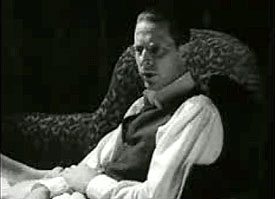 The first volume of The Lovecraft Collection was issued in 2004, featuring films from the H. P. Lovecraft Film Festival, an annual event in Portland, Oregon.
The first volume of The Lovecraft Collection was issued in 2004, featuring films from the H. P. Lovecraft Film Festival, an annual event in Portland, Oregon.
As would prove the case with later volumes too, it has a "main" feature & several short subjects, ranging from the & the absolutely awful, some of it so bad one suspects a core group of talentless buddies with a mutual admieration society voted each other in.
But with the title item, Bryan Moore's Cool Air (1999), we have something very, very nice, so it really doesn't matter if the rest of the material on the disc is such a far cry from brilliant.
Grainy but nevertheless excellent black & white cinematography shows us a slender fellow in 1920s costume arriving by foot with two suitcases at a boardinghouse that declares itself with "Room to Let."
We're that quickly in Cool Air, based on a story of the same title by H. P. Lovecraft. Howard wrote the tale in 1926, & got it published in the pulp magazine Tales of Magic & Mystery (March, 1928). Lovecraft was personally hyper-sensitive to cold, & so managed to wring a horror yarn from his own response to environment.
The landlady is played by a delightful character actress, Vera Lockwood, who died shortly after the filming. Our protagonist, Randolph Carter, is odd enough to be inherently interesting, & is played by the director himself. Carter is one of the more famous characters from the writings of H. P. Lovecraft, met in "The Statement of Randolph Carter," "The Dream-Quest of Unknown Kadath," & a few other tales, always as a very thinly disguised self-portrait.
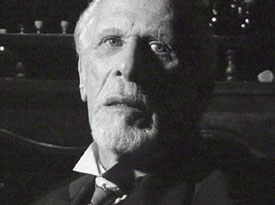 Carter is not in the original tale of "Cool Air" where the protagonist is nameless. I rather like the notion that he might've been Carter, however, & fun to speculate how it would fit into Carter's larger history. Carter is not in the original tale of "Cool Air" where the protagonist is nameless. I rather like the notion that he might've been Carter, however, & fun to speculate how it would fit into Carter's larger history.
He calls himself a writer "of magazine articles mostly," as he sets out a small electric fan & his typewriter. He is that quickly prepared for some alone-time to write in the harsh, minimally appointed room.
In the room above his dwells a reclusive occult physician, Dr. Munoz. One day Carter has a cardiac event & staggers up the stairs to the old doctor's room for help, which he luckily obtains. He takes Dr. Munoz's treatment, sleep for twenty-four hours, & awaken completely well. Munoz even promises Carter that he will never again be ill, not for the rest of his life.
The small cast all do a great job of it, but Jack Donner as Munoz is tremendous. He gives his character gravity, as his anguished history is revealed.
The doc's room is exceedingly chill. A gothic-looking refrigeration device sits perpetually cooling the air in the otherwise comfortable rooms. Dr. Munoz's is himself cold to the touch, & his terror of warmth is why he never leaves his apartment.
Carter & Munoz become friends, with Carter repairing to his upstairs neighbor's cold rooms for quiet evenings. Munoz tells his own story of how, two decades before, he nearly died of a mysterious condition. The treatment though otherwise effective requires that he live the rest of life refrigerated "like perishable food."
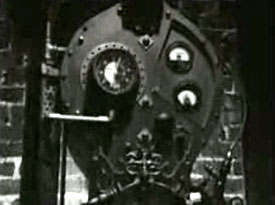 It's a very talky script with very little overt occurring, so can test one's patience upon occasion, though in general the level of acting is such that it's very appealing. It's a very talky script with very little overt occurring, so can test one's patience upon occasion, though in general the level of acting is such that it's very appealing.
In general style it is reminiscent of vintage television fantasy/horror, such tales often airing in anthology series of the 1950s such as One Step Beyond, Thriller, Science Fiction Theater, & the most successful of them all, The Twilight Zone.
Those spare programs often had little more in them than talking heads to support strong scripts, such fine acting & shadowy photography that the atmospherics rather than FX or action or a multitude of locations carried the day.
One day Dr. Munoz's refrigeration unit burns out & he goes into a panic, as he's in grave danger. Carter sets out to find ice to keep Munoz cold, & a repairman for the unit. But when he returns, Munoz will let no one in the room, for it's too late. All too soon, Munoz is melting away into putriscent flesh.
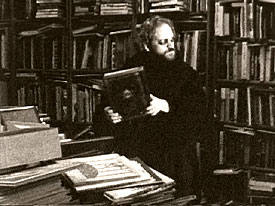 Cool Air is a shortish film weighing in a mite under three-quarters of an hour. But there are plenty of minutes of material, thanks to the numerous extras.
Cool Air is a shortish film weighing in a mite under three-quarters of an hour. But there are plenty of minutes of material, thanks to the numerous extras.
The best of the added items is Beyond the Machine: Interviews with the Cast & Crew of Cool Air (2004). It introduces us to the director who played Carter, the cinematographer, the editor, actor Jack Donner who played the chill doctor, & comedic character actor Michael Sonye who frequently goes by the name "Dukey Flyswatter" & who spices up the film with an antic performance delivering ice, Oh, & Andrew Miglione the Lovecraft Film Festival director & director of this nicely done documentary.
All these folks are delightful individuals full of enthusiasm, sincerity, & intelligence. Jack Donner in particular had great stories to tell about the production. Dukey gets the final word by right of his natural comedic oddness.
The rest of the extras range from adequate to just awful, so really only Cool Air & it's half-hour support-documentary are unreservedlyk recommendable. But for Lovecraft fandom, the rest of this "cinematic fanzine" will be worth the trouble of viewing, no matter how dubious the merits.
A couple tiny extras are very trivial indeed, Dunwich 1927 (2000) & The Scroll (2000) having been ads & introductory openers made specifically for the Lovecraft Film Festival. These are not credited as to director, but they are hasty works of Anthony Penta.
In Dunwich 1927, sepia rather than black & white gives it a moody look, & it emulates a film from the silent era. It's intentionally ridiculous, as a clownish protagonist wearing plastic Halloween teeth thumbs through a copy of The Necronomicon. This is the most horrifying & dangerous book of demonic magic ever written, but our protagonist is delighted to find in it an a full-page ad for the Lovecraft film fest.
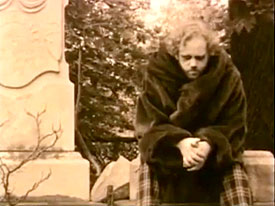 The Scroll is likewise a joke, not a particularly good one. There's also an interview with "big name fan" S. T. Joshi on H. P. Lovecraft, of likewise slight interest, Joshi having the charisma of the shoe Werner Herzog ate. The Scroll is likewise a joke, not a particularly good one. There's also an interview with "big name fan" S. T. Joshi on H. P. Lovecraft, of likewise slight interest, Joshi having the charisma of the shoe Werner Herzog ate.
Slightly more consequential among the extras are four short subjects, micromovies either inspired by Lovecraft or based on his tales. None, alas, are excellent works, but they're all short enough to get through without suffering.
First under consideration is Anthony Penta's The Hapless Antiquarian (2001), seven minutes in sepia tones, emulating cinema of the 1920s. It cheats as a silent movie as there is a soundtrack with a narrator explaining to us what we are seeing. This narration is in rhyme & severely silly, in weak imitation of Edward Gorey.
The antiquarian found a mystic book which was to ruin his life. This is the only Lovecraft connection, as the rest is Goreyesque, going through the alphabet with lines like "K was the Kurd who bought the black book. L was the laugh that he made till he shook...."
Amusing, exceedingly slight, with text better than the film though neither is much to brag about. Spotting a photograph of Bela Lugosi was the only thing that made me grin.
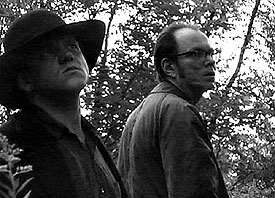 Penta also contributes The Hound (1997) at eighteen minutes, based on the tale of the same name by HPL.
Penta also contributes The Hound (1997) at eighteen minutes, based on the tale of the same name by HPL.
Lovecraft wrote it somewhat tongue-in-cheek, burlesquing his own tendency to over-write mood & horrific response. It was completed in 1922 & appeared in Weird Tales (February 1924). It's the first story in which he ever mentioned The Necronomicon.
The film is in black & white, & has moody moments, though overall Penta just isn't much of a filmmaker. He usually goes for laughs (bad filmmakers frequently & mistakenly believe comedy is easy, & doing a bad job is excused with the sentiment that it's all a joke). With The Hound, however, he tries to treat the story fairly, & falls on his face.
The conventional approach to micromovies based on Lovecraft is to have the narrator tell you what's happening. It can work at times but it's more often a terrible way of telling a tale in a pictorial medium like cinema. It permits a filmmaker to cheat at every turn since if what you see on the screen makes no earthly sense, doesn't matter, the narrator's explaining it.
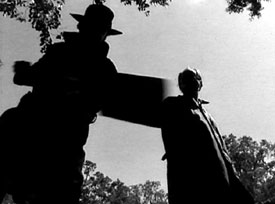 On the other hand, it does permit using a few of Lovecraft's own words to trump up such a narration. So when a film is a failure, at least the script had echoes of something that was better. On the other hand, it does permit using a few of Lovecraft's own words to trump up such a narration. So when a film is a failure, at least the script had echoes of something that was better.
It starts with the hoary image of the narrator writing what we are hearing on the soundtrack. So we get a double-dose of telling, not showing, in a visual medium no less.
In flashback or re-enactment of the manuscript-in-progress, we see our narrator & his friend St. John thumbing through books of diabolism, including a copy of The Necronomicon. They look as bored as I'm feeling while watching them be bored.
This queer couple take to graverobbing for kicks, because what defeats boredom more fully than the rancid odor of decayed flesh. When they dig up the grave of Nathan Lowe, prying open the century-old coffin, they see a skeleton in a tuxedo which someone seems to have placed on him fresh that afternoon.
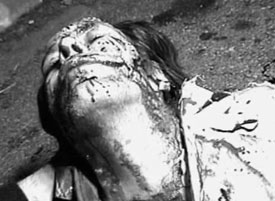 The dapper skeleton has a necklace with a carving of a sinister winged god or demon with doggy face. The dapper skeleton has a necklace with a carving of a sinister winged god or demon with doggy face.
Naturally, our boys steal the pendant. At that very moment they first heard the abhorrent hound, a sound that will continue to haunt them.
We suffer through these dufuses walking about, sitting, looking about, & other tedious endeavors that pad this turkey out to eighteen-minutes, which seems like hours. At long last it gets round to the doom of St. John. The uninteresting doom I should say.
Our narrator, who is still writing all this down, knows the hound will get him next, unless he defeats it by committing suicide. I wish he'd killed himself before ruining HPL's "The Hound."
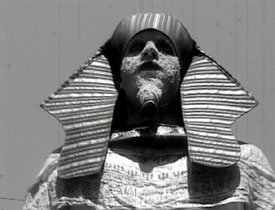 Christian Matzke's Nyarlathotep (2001) is another "narrated" film, but this time it's a literal reading of Lovecraft's prose-poem, put to pictures.
Christian Matzke's Nyarlathotep (2001) is another "narrated" film, but this time it's a literal reading of Lovecraft's prose-poem, put to pictures.
The 1920 prose-poem evokes cosmic divnities, but the film evokes a goofy vaudeville magician. So words & pictures don't corrolate all that well.
Set in the town of Arkham in 1920, shot in black & white with an effectively vintage look to it, it manages to be charming in spite of bad acting & mediocre voice-acting for the reading.
The vaudeville magician Nyarlathotep (Dan Harrod), we learn in flashback, was found as a statue that came to life, from an Egyptian archeological site.
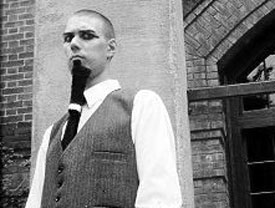 Adapting to the modern world, except always with pharaoh-like eye make-up, he became famous for an act "horrible beyond imagining." Horrible as in just plain bad, & it's hard to know how seriously the director thought he was being. Adapting to the modern world, except always with pharaoh-like eye make-up, he became famous for an act "horrible beyond imagining." Horrible as in just plain bad, & it's hard to know how seriously the director thought he was being.
He does his act on the Arkham vaudeville stage. It's all amateur hokum that is a bit hard to take, but has fannish campiness so not entirely boring. It builds towards mere intimations of being a Creature Feature plus time travel that's almost eerie in spite of the intrusions of high camp.
Alas the drawn-out prophesy of future chaos is mainly illustrated with stock footage, so the feeling of inconsequentiality is heightened by the end.
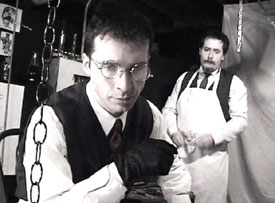 A second film by Christian Matzke shares the trait of charming amateurism, An Imperfect Solution: A Tale of the Re-Animator (2003) filmed in glorious black & white, & based on HPL's tale "Herbert West, Re-Animator," the inspiration for Stuart Gordon's thrilling Re-Animator (1985). A second film by Christian Matzke shares the trait of charming amateurism, An Imperfect Solution: A Tale of the Re-Animator (2003) filmed in glorious black & white, & based on HPL's tale "Herbert West, Re-Animator," the inspiration for Stuart Gordon's thrilling Re-Animator (1985).
A minor work for Lovecraft, which he himself called "drivel," it was furst published it in an amateur journal in 1922. It's chief claim to fame is providing the first-ever mention of Miskatonic University, the alma mater of many a Lovecraft fan. It imagines zombies as animalistic & violent, though in 1922 the resurged dead were generally depicted mind-controlled slaves, not as enraged killers.
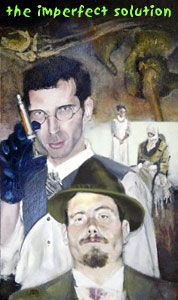 So HPL "predicted" how zombies would come to be depicted in future cinema, excluding however An Imperfect Solution which retains very little of Lovecraft's sketch. So HPL "predicted" how zombies would come to be depicted in future cinema, excluding however An Imperfect Solution which retains very little of Lovecraft's sketch.
Herbert (BobPoirier) & Simon (Jason C. Waron) have been snatching bodies from the Miskatonic morgue, but they're never fresh enough to successful re-animate.
Set in the 1920s, Simon has to leave for a few days by train, attending his grandmother's funeral. While he's gone, Herbert kills a travelling salesman to get the freshest possible body.
When Simon returns, he seems to believe Herbert's ridiculous explanation for how he got such a fresh body, which he was careful to preserve so Simon could participate in the ultimate experiment.
The formula is injected, but the travelling salesman returns to life only long enough to tell Simon that Herbert murdered him.
Poorly scripted, very badly acted, & terrible staging, I wasn't all that entertained by this awful little film.
Continue to:
The H. P. Lovecraft Collection Volume 2: Dreams of Cthulhu (2007)
copyright © by Paghat the Ratgirl
|
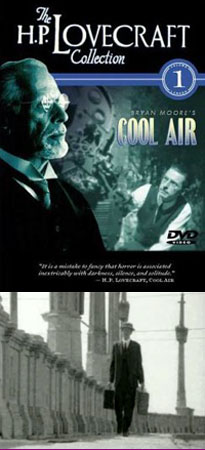

 Carter is not in the original tale of "Cool Air" where the protagonist is nameless. I rather like the notion that he might've been Carter, however, & fun to speculate how it would fit into Carter's larger history.
Carter is not in the original tale of "Cool Air" where the protagonist is nameless. I rather like the notion that he might've been Carter, however, & fun to speculate how it would fit into Carter's larger history. It's a very talky script with very little overt occurring, so can test one's patience upon occasion, though in general the level of acting is such that it's very appealing.
It's a very talky script with very little overt occurring, so can test one's patience upon occasion, though in general the level of acting is such that it's very appealing. Cool Air is a shortish film weighing in a mite under three-quarters of an hour. But there are plenty of minutes of material, thanks to the numerous extras.
Cool Air is a shortish film weighing in a mite under three-quarters of an hour. But there are plenty of minutes of material, thanks to the numerous extras. The Scroll is likewise a joke, not a particularly good one. There's also an interview with "big name fan" S. T. Joshi on H. P. Lovecraft, of likewise slight interest, Joshi having the charisma of the shoe Werner Herzog ate.
The Scroll is likewise a joke, not a particularly good one. There's also an interview with "big name fan" S. T. Joshi on H. P. Lovecraft, of likewise slight interest, Joshi having the charisma of the shoe Werner Herzog ate. Penta also contributes The Hound (1997) at eighteen minutes, based on the tale of the same name by HPL.
Penta also contributes The Hound (1997) at eighteen minutes, based on the tale of the same name by HPL. On the other hand, it does permit using a few of Lovecraft's own words to trump up such a narration. So when a film is a failure, at least the script had echoes of something that was better.
On the other hand, it does permit using a few of Lovecraft's own words to trump up such a narration. So when a film is a failure, at least the script had echoes of something that was better. The dapper skeleton has a necklace with a carving of a sinister winged god or demon with doggy face.
The dapper skeleton has a necklace with a carving of a sinister winged god or demon with doggy face. Christian Matzke's Nyarlathotep (2001) is another "narrated" film, but this time it's a literal reading of Lovecraft's prose-poem, put to pictures.
Christian Matzke's Nyarlathotep (2001) is another "narrated" film, but this time it's a literal reading of Lovecraft's prose-poem, put to pictures. Adapting to the modern world, except always with pharaoh-like eye make-up, he became famous for an act "horrible beyond imagining." Horrible as in just plain bad, & it's hard to know how seriously the director thought he was being.
Adapting to the modern world, except always with pharaoh-like eye make-up, he became famous for an act "horrible beyond imagining." Horrible as in just plain bad, & it's hard to know how seriously the director thought he was being. A second film by Christian Matzke shares the trait of charming amateurism, An Imperfect Solution: A Tale of the Re-Animator (2003) filmed in glorious black & white, & based on HPL's tale "Herbert West, Re-Animator," the inspiration for Stuart Gordon's thrilling Re-Animator (1985).
A second film by Christian Matzke shares the trait of charming amateurism, An Imperfect Solution: A Tale of the Re-Animator (2003) filmed in glorious black & white, & based on HPL's tale "Herbert West, Re-Animator," the inspiration for Stuart Gordon's thrilling Re-Animator (1985). So HPL "predicted" how zombies would come to be depicted in future cinema, excluding however An Imperfect Solution which retains very little of Lovecraft's sketch.
So HPL "predicted" how zombies would come to be depicted in future cinema, excluding however An Imperfect Solution which retains very little of Lovecraft's sketch.